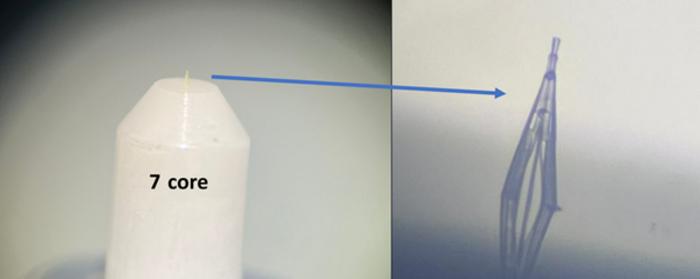Nanotechnology could treat lymphedema
The human body is made up of thousands of tiny lymphatic vessels that ferry white blood cells and proteins around the body, like a superhighway of the immune system. It’s remarkably efficient, but if damaged from injury or cancer treatment, the whole system starts to fail. The resulting fluid retention and swelling, called lymphedema, isn’t […]

The human body is made up of thousands of tiny lymphatic vessels that ferry white blood cells and proteins around the body, like a superhighway of the immune system. It’s remarkably efficient, but if damaged from injury or cancer treatment, the whole system starts to fail. The resulting fluid retention and swelling, called lymphedema, isn’t just uncomfortable — it’s also irreversible.

Credit: Georgia Tech
The human body is made up of thousands of tiny lymphatic vessels that ferry white blood cells and proteins around the body, like a superhighway of the immune system. It’s remarkably efficient, but if damaged from injury or cancer treatment, the whole system starts to fail. The resulting fluid retention and swelling, called lymphedema, isn’t just uncomfortable — it’s also irreversible.
When lymphatic vessels fail, typically their ability to pump out the fluid is compromised. Georgia Institute of Technology researchers have developed a new treatment using nanoparticles that can repair lymphatic vessel pumping. Traditionally, researchers in the field have tried to regrow lymphatic vessels, but repairing the pumping action is a unique approach.
“With many patients, the challenge is that the lymphatic vessels that still exist in the patient aren’t working. So it’s not that you need to grow new vessels that you can think of as tubes, it’s that you need to get the tubes to work, which for lymphatic vessels means to pump,” said Brandon Dixon, a professor in the George W. Woodruff School of Mechanical Engineering. “That’s where our approach is really different. It delivers a drug to help lymphatic vessels pump using a nanoparticle that can drain into the diseased vessels themselves.”
The researchers published their findings in “Lymphatic-Draining Nanoparticles Deliver Bay K8644 Payload to Lymphatic Vessels and Enhance Their Pumping Function” in Science Advances in February.
The Benefit of Nanotechnology for Drug Delivery
The drug the researchers used, S-(-)-Bay K8644 or BayK, normally targets L-type calcium channels that enable the skeletal, cardiac, and endocrine muscles to contract. In effect, the application of BayK throughout the body would lead to convulsions and spasms.
Using nanoparticles designed to drain into lymphatic vessels after injection focuses the drug solely into the lymphatic vessels, draining the injection site. As a result, the drug is available within lymphatic vessels at a locally high dose. When lymph is eventually returned into the circulation, it’s diluted in the blood so much that it doesn’t affect other systems in the body, making the drug for lymphedema applications both targeted and safe.
“Lymphatic tissues work like river basins — regionally you have vessels that drain the fluid out of your tissues,” said Susan Thomas, Woodruff Associate Professor of Mechanical Engineering in the Parker H. Petit Institute for Bioengineering and Bioscience. “This method is like putting nanoparticles in the river to help the river flow better.”
The research is the perfect blend of Dixon’s and Thomas’ respective expertise. Dixon’s lab has been studying how lymphatics function in animal models for years. Thomas engineers nanoparticle drug delivery technologies that deploy in the lymphatic system.
“He develops analysis tools and disease models related to the lymphatic system, and I develop lymphatic-targeting drug delivery technologies,” Thomas said. “Tackling lymphedema as a widely prevalent condition for which there are no efficacious therapies was the perfect opportunity to leverage our strengths to hopefully move the needle on developing new strategies to serve this underserved patient population.”
Testing the Therapy
The Dixon and Thomas lab teams tested the formulation using rodent models. They first mapped the model’s lymph node system by injecting a fluorescent substance to see how it traveled. Then they applied a pressure cuff to measure how the lymphatic system fails to function when compromised. From there, they evaluated how formulating BayK in a lymph-draining nanoparticle influenced the drug’s effects. The delivery system allowed the drug to act within the lymphatic vessel, as demonstrated by increased vessel pumping and restored pumping pressure, and drastically reduced the concentration of BayK in the blood, which is typically associated with unwanted side effects.
The researchers are expanding the formulation to more advanced disease models to move it closer to human application. They will also explore how it can be used to prevent or treat lymphedema in combination with other existing or new therapies now being developed.
CITATION: Sestito, L.F., To, K., Cribb, M., Archer, P.A., Thomas, S.N.§, Dixon, J.B.§, 2023. Lymphatic-draining nanoparticles deliver Bay K8644 payload to lymphatic vessels and enhance their pumping function. Science Advances. 6: eabd7134.
DOI: DOI: 10.1126/sciadv.abq0435
#####
The Georgia Institute of Technology, or Georgia Tech, is one of the top public research universities in the U.S., developing leaders who advance technology and improve the human condition. The Institute offers business, computing, design, engineering, liberal arts, and sciences degrees. Its more than 45,000 undergraduate and graduate students, representing 50 states and more than 148 countries, study at the main campus in Atlanta, at campuses in France and China, and through distance and online learning. As a leading technological university, Georgia Tech is an engine of economic development for Georgia, the Southeast, and the nation, conducting more than $1 billion in research annually for government, industry, and society.
Journal
Science Advances
DOI
10.1126/sciadv.abq0435
Method of Research
Experimental study
Subject of Research
Animals
What's Your Reaction?

































